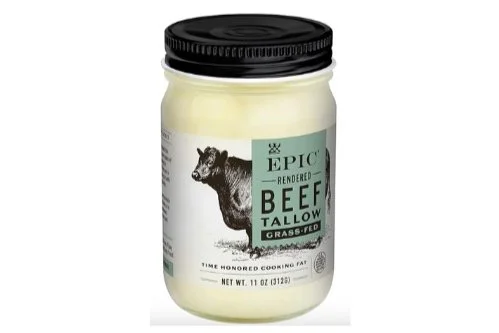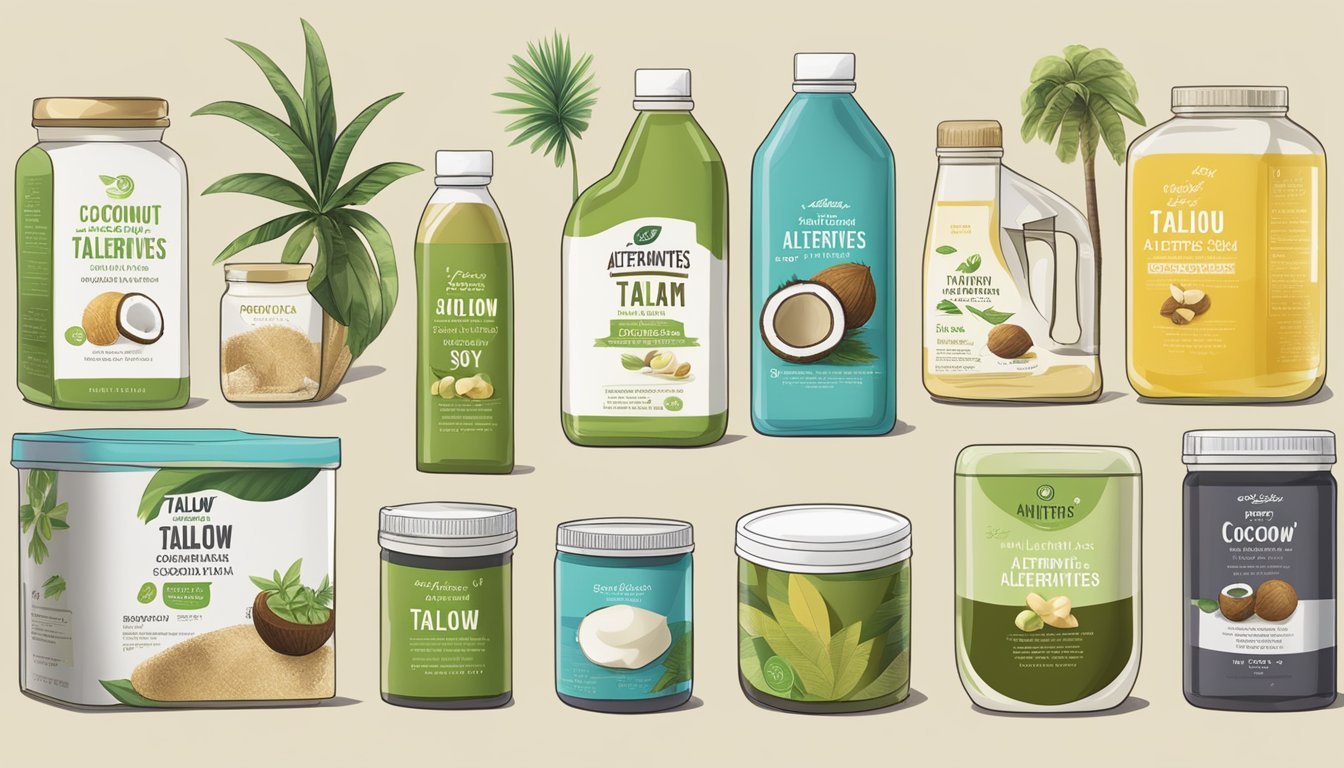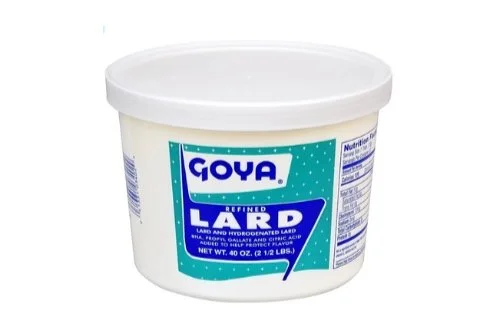What Is Tallow: Uses, Benefits, and Production Methods
Tallow, a historically significant and versatile substance, is a form of rendered fat primarily extracted from beef or mutton. Recognized for its multitude of applications, tallow has been a staple in both culinary and non-culinary contexts for centuries. Tallow consists of solidified fats that offer a rich source of healthy fats, vitamins, and conjugated linoleic acid (CLA).
Emerging interest in traditional and ancestral diets has brought tallow back into the spotlight for modern cooking and baking. With its high smoke point, tallow serves as an excellent substitute for oils or butter, making it ideal for frying and roasting. Additionally, its dense nutrient profile supports not just culinary uses but also skincare, promoting hydration and the potential reduction of inflammation.
Beyond its nutritional benefits, tallow has also been utilized in the production of soap, candles, and lubricants. The process of rendering fat to make tallow transforms otherwise discarded animal fat into a valuable and sustainable resource, underlining its relevance in both historical and contemporary practices. Whether used in the kitchen or the bathroom, tallow presents a multifaceted and eco-friendly option worth exploring.
Historical Significance
Tallow has been a vital component in various cultures, appreciated for its diverse applications. From ancient skincare practices to its role in daily living, the significance of tallow extends across different historical periods.
Traditional Uses of Tallow
Tallow, primarily derived from beef suet, served as a key ingredient in many traditional activities. It was instrumental in candle making, providing a reliable source of light before the advent of electric lighting. These tallow candles were popular due to their slow-burning properties.
In addition, tallow was central in the production of soaps. The tallow-based soap was known for its cleansing and moisturizing qualities, making it a staple in personal hygiene over the centuries.
Moreover, indigenous cultures utilized tallow in food preservation. They created pemmican, a mixture of tallow, dried meat, and berries, as a high-energy food that could be stored for long periods. This was crucial for sustenance during harsh winters and long journeys.
Development Over Time
Over centuries, the use of tallow has evolved while maintaining its importance in various sectors. Initially, its primary uses included lighting and cooking, but gradually, its applications expanded. By the Middle Ages, people had developed techniques to purify tallow, enhancing its quality and usability.
During the Industrial Revolution, tallow continued to be a significant resource. It was used as a lubricant for machinery and as a raw material for producing biodiesel, demonstrating its utility beyond traditional domestic uses.
In more recent times, tallow has experienced a revival in the skincare industry. Its natural properties as a moisturizer have made it popular among enthusiasts seeking traditional and sustainable skincare options. The rich historical legacy of tallow underscores its enduring versatility and value.
Production Process
The production of tallow involves the transformation of raw animal fat, specifically suet, into a usable product through various methods such as rendering and purification.
Rendering Techniques
Rendering is the primary method used to produce tallow.
It involves heating the raw fat, typically suet, to separate pure fat from impurities and other elements.
Dry rendering and wet rendering are the two common techniques.
Dry rendering applies heat to the fat without adding water, while wet rendering involves boiling the fat in water, which helps in separating the oil more efficiently.
Both techniques aim to melt the fat, allowing it to be strained and purified.
From Suet to Tallow
The process starts with raw suet, the hard fat surrounding the kidneys and loins of animals.
Suet is chopped into small pieces to facilitate melting.
These pieces are then gently heated in a pot over low flame, which gradually melts the fat.
Once melted, it is strained through a cheesecloth or coffee filter to remove solid impurities known as "cracklings."
The clear liquid fat obtained is then cooled and solidified, forming what is known as tallow.
Purification Steps
After rendering, tallow undergoes several purification steps.
The liquid is poured into containers and allowed to harden.
To ensure high purity, tallow might be melted again and strained multiple times.
Simmering the tallow first aids in removing any remaining impurities.
The final product is a waxy, white substance free from unwanted particles, making it suitable for various uses in cooking and industrial applications.
Nutritional Information
Tallow is a dense source of energy and nutrients, containing significant amounts of fats and fat-soluble vitamins. It provides essential fatty acids and is particularly beneficial for certain dietary approaches like keto and low-carb diets.
Fatty Acids Profile
Tallow's fatty acid composition includes a substantial amount of saturated fats, predominantly myristic acid. This fat is also found in other animal fats and various oils. Tallow comprises 45-50% saturated fat, 42-50% monounsaturated fat, and around 4% polyunsaturated fat.
Monounsaturated fats present in tallow, such as oleic acid, are considered heart-healthy. The minimal polyunsaturated fat content makes tallow stable for cooking at high temperatures.
Vitamins and Minerals Content
Beef tallow is rich in fat-soluble vitamins that are crucial for maintaining health. A tablespoon of tallow offers vitamins like A, D, E, and K2. For instance, every tablespoon provides approximately 0.35 mg of Vitamin E and 4 IUs of Vitamin D.
Additionally, tallow contains 10 mg of choline and 79.8 mg of cholesterol per serving. These components contribute significantly to brain and cell membrane health, as well as hormone production.
Comparative Health Impacts
The impact of tallow on health can be nuanced. While the high saturated fat content in tallow can raise concerns, saturated fats are essential in moderation for hormone production and cellular integrity. Grass-fed tallow often contains more nutrients, including conjugated linoleic acid (CLA), which has been linked to potential anti-carcinogenic properties and metabolic benefits.
On the other hand, tallow's absence of carbohydrates makes it compatible with low-carb and ketogenic diets. The high monounsaturated fat content, especially oleic acid, is known for its positive effect on heart health, similar to olive oil.
Clear and balanced, this nutritional profile of tallow indicates diverse health benefits but should be consumed with consideration of individual dietary needs and health status.
Culinary Uses
Tallow serves as a versatile cooking fat in the kitchen, appreciated for its high smoke point and distinct flavor contributions. When compared with vegetable oils, it offers unique benefits but comes with its considerations regarding health and culinary applications.
Tallow in Cooking and Baking
Tallow is widely used in cooking and baking due to its high smoke point, which is around 420°F (215°C). This makes it ideal for frying, roasting, and searing, allowing food to cook at higher temperatures without burning the fat.
When used in baking, tallow provides a rich texture and depth of flavor to pastries and crusts, similar to what you get with lard or shortening. Additionally, because tallow is a saturated fat, it remains solid at room temperature, which can help maintain the structure of baked goods.
If you're looking for tallow, buying it online is your best bet!
Comparison with Vegetable Oils
When comparing tallow with vegetable oils like olive oil and canola oil, notable differences emerge. Tallow has a higher smoke point than many common vegetable oils, making it superior for frying and grilling. While olive oil and virgin olive oil are favored for their health benefits, they do not perform as well under high heat.
Vegetable oils are often preferred for their lower saturated fat content. However, tallow from grass-fed beef has been highlighted for its healthier fatty acid profile compared to conventional beef fat. Thus, making tallow a better choice for certain high-heat applications.
Flavor and Aroma Contributions
Tallow imparts a distinct, savory flavor to dishes, which can enhance the taste of certain foods like French fries, roasted vegetables, and meats. This characteristic makes it highly valued in traditional and rustic cooking styles.
Its aroma is clean and light if the tallow is pure, thus not overpowering other ingredients in a dish. The rich flavor profile of beef tallow also makes it a popular choice for searing and sautéing meats, contributing to a desirable, deep flavor that vegetable oils may not provide.
Industrial and Commercial Applications
Tallow, derived mainly from beef and sheep fat, finds diverse uses in various industries due to its unique characteristics. Its applications range from manufacturing and food production to beauty and skincare products.
Tallow in Manufacturing
Tallow plays a significant role in manufacturing, particularly as a lubricant. Its use in light engineering tasks, such as cutting threads on electrical conduits, showcases the versatility of this animal fat.
Industries involved in metalworking often use tallow-based lubricants for their ability to reduce friction and wear. Moreover, there is a growing trend of replacing traditional tallow-based lubricants with synthetic variants for cleaner surfaces in specific rolling applications.
Tallow is also a key ingredient in soap making. The fatty acids derived from tallow create a firm, long-lasting soap bar that lathers well.
Food Industry Utilization
In the food industry, tallow is used for its high melting point and stable nature. It is a favored choice for deep frying and cooking due to its ability to withstand high temperatures without breaking down.
Baked goods also benefit from tallow's properties. It helps create flaky textures in pastries and pie crusts. Additionally, it contributes a distinct flavor to dishes, particularly in traditional and regional cuisines where tallow is a staple.
Tallow has made its mark in biodiesel production as well. The process of converting animal fat into fuel presents a viable alternative to traditional fossil fuels. This not only provides a use for by-products but also supports sustainability efforts.
Beauty and Skincare Products
Tallow is lauded for its skincare benefits, making it a popular ingredient in beauty products. Its composition is similar to human sebum, which helps it moisturize and nourish the skin effectively.
Tallow-based balms and creams are especially noted for their ability to improve skin barrier function and retain moisture. These properties make tallow suitable for people with dry or sensitive skin.
In soaps and lotions, tallow provides a rich, creamy texture that enhances the overall user experience. It's preferred for producing long-lasting, high-quality products that deliver considerable skin benefits without the need for synthetic additives.
Health and Wellness
Tallow possesses unique health properties and potential benefits for heart and skin health, offers anti-inflammatory effects, but also comes with certain risks.
Benefits for Heart and Skin Health
Beef tallow contains various fats including myristic acid and is a rich source of fat-soluble vitamins such as A, D, E, and K. These nutrients support essential bodily functions and contribute positively to heart and skin health.
For the heart, the presence of omega-3 fatty acids in tallow can help maintain cholesterol levels. For the skin, tallow can improve moisture and treat dry skin, enhancing skin flexibility and healing abilities. Its topical application can strengthen the skin barrier and increase hydration.
Anti-Inflammatory Properties
Tallow contains substances that exhibit anti-inflammatory properties. Omega-6 fats in balanced amounts can help reduce inflammation. This is important because chronic inflammation is linked to various health issues including heart disease and cancer.
The suggestion that tallow may help with inflammation adds to its appeal for those seeking natural methods to manage inflammatory conditions. While the exact mechanisms are still under study, the inclusion of these fats in a balanced diet could be beneficial.
Potential Risks
Despite its benefits, tallow has potential risks. Its high saturated fat content could contribute to elevated cholesterol levels if consumed excessively. This may increase the risk of heart disease for some individuals.
Additionally, improper balance between omega-6 and omega-3s could exacerbate inflammation rather than reduce it. Careful dietary management is necessary to avoid such outcomes. It's essential to integrate tallow mindfully within a diet to mitigate these risks effectively.
The Science of Cooking Fats
Cooking fats play a crucial role in culinary processes, especially during high-heat cooking methods such as frying and deep frying. Key factors include the smoke point of the fat and its behavior under high temperatures.
Understanding Smoke Points
The smoke point of a cooking fat is the temperature at which it starts to smoke and break down. High smoke point fats, such as beef tallow and vegetable oils, are ideal for high-heat cooking.
Smoke points (approximate values):
Beef Tallow: 400°F (204°C)
Canola Oil: 400°F (204°C)
Olive Oil: 375°F (191°C)
Fats with lower smoke points, like butter, may burn before reaching the necessary temperature for frying, leading to undesirable flavors and potential health concerns. Knowing the smoke point helps chefs choose the right fat for the right cooking method, ensuring safety and flavor integrity.
The Role of Fats in High-Heat Cooking
During high-heat cooking, fats not only help transfer heat but also contribute to flavor and texture. Fats like beef tallow, which have high oxidative and thermal stability, maintain their properties over extended cooking times, making them suitable for continuous use in deep frying.
Key roles of fats in high-heat cooking:
Heat Transfer: Provides even heat distribution.
Flavor Contribution: Adds and enhances flavor.
Texture Improvement: Contributes to crispiness and moisture retention in food.
The low polyunsaturated fat content in beef tallow (<4%) makes it resistant to oxidation, even after prolonged exposure to high temperatures. This characteristic is vital to prevent the production of harmful oxidation products. Proper selection of fats based on their properties can significantly impact the quality and safety of the cooked food.
Environmental and Ethical Considerations
Tallow production involves various environmental factors and ethical concerns. Key points to consider include the sustainability of sourcing practices and the welfare of animals involved.
Sourcing and Sustainability
The environmental impact of tallow depends significantly on sourcing practices. Grass-fed and pasture-raised livestock tend to have lower environmental footprints compared to grain-fed animals. Sustainable farming techniques aim to minimize ecological disruption and maintain soil health.
Purchasing tallow from responsibly managed farms can ensure that the production aligns with eco-friendly principles. Transparent supply chains are crucial in establishing trust and verifying that practices like ethical sourcing and sustainable agriculture are upheld.
Animal Welfare
Animal welfare in tallow production involves ensuring that livestock are treated humanely. Grass-fed and pasture-raised animals typically have better living conditions, contributing to higher welfare standards. Ethical tallow production should avoid confinement and promote natural behaviors.
Consumers may consider brands that adhere to strict welfare standards and transparent practices. This can include ensuring animals are raised in humane conditions, free from unnecessary stress, and have access to natural diets and environments.
Tallow Alternatives
Tallow can be substituted with both plant-based and animal-based options depending on dietary preferences, availability, and specific uses. Each alternative brings unique properties that may better suit certain applications over others.
Plant-Based Substitutes
Vegetable Oils: Common alternatives include canola, coconut, and vegetable oils. They have high smoke points, making them ideal for frying and sautéing. Olive oil, while rich in flavor and healthy fats, has a lower smoke point and is better suited for low-heat cooking and dressings.
Beeswax: In non-cooking applications, such as skincare, beeswax can be a substitute due to its protective qualities, though it lacks the nutritional profile found in fats.
Animal-Based Alternatives
Lard: Made from rendered pig fat, lard is highly versatile. It has a texture and flavor similar to tallow, making it suitable for cooking and baking. It is also great for making flaky pastries.
Schmaltz: Rendered chicken fat, known as schmaltz, is another alternative. It offers a distinct flavor that enhances roasted and pan-fried dishes.
Dripping: Beef or pork dripping, the fat collected during roasting, is a practical substitute. It provides a rich, savory flavor ideal for gravies and frying.
Duck Fat: With a smoke point of 375°F, duck fat is good for roasting and pan-frying. It is rich in flavor but can be more expensive.
Each substitute has its unique characteristics that may make it more suitable for specific culinary or non-culinary uses.
When it comes to getting the best deals, buying lard online is the way to go!









